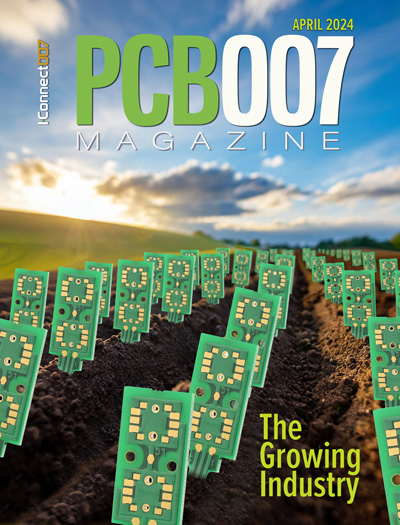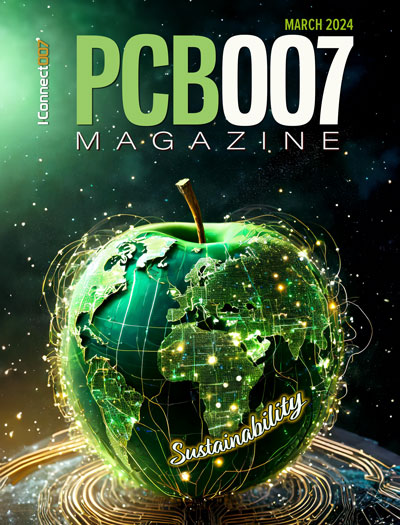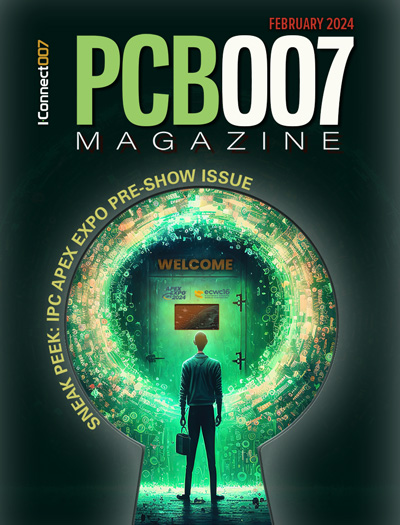-

- News
- Books
Featured Books
- pcb007 Magazine
Latest Issues
Current Issue
The Growing Industry
In this issue of PCB007 Magazine, we talk with leading economic experts, advocacy specialists in Washington, D.C., and PCB company leadership to get a well-rounded picture of what’s happening in the industry today. Don’t miss it.

The Sustainability Issue
Sustainability is one of the most widely used terms in business today, especially for electronics and manufacturing but what does it mean to you? We explore the environmental, business, and economic impacts.

The Fabricator’s Guide to IPC APEX EXPO
This issue previews many of the important events taking place at this year's show and highlights some changes and opportunities. So, buckle up. We are counting down to IPC APEX EXPO 2024.
- Articles
- Columns
Search Console
- Links
- Events
||| MENU - pcb007 Magazine
New CEO Jeff Waters Outlines his Roadmap for Isola
February 8, 2016 | Barry Matties, I-Connect007Estimated reading time: 26 minutes
Jeff Waters, Isola’s newly appointed CEO and president, comes to the laminate supplier after more than 25 years in the semiconductor industry, working for companies like Texas Instruments and National Semiconductor. Only a few days into his new job, I met with Jeff to discuss the transition and what we can expect from Isola under his leadership.
Barry Matties: Jeff, you are now the president and CEO of Isola. How does that feel?
Jeff Waters: It feels great. It’s very exciting.
Matties: Just for a little context, why don't you start by sharing a little bit of your background for our readers.
Waters: I started my career working for National Semiconductor in a wafer fab as a process engineer and did that for about four or five years. Then I went over to Japan with a research fellowship with Fujitsu Laboratories and did some semiconductor research there before coming back to go to business school in Chicago. I worked in management consulting for a few years, and then went back to National. This was in the early to mid-'90s, and since then I’ve spent the rest of my time working in semiconductors.
Looking back on it, one of the nice things about working for a company like National Semiconductor or Texas Instruments is that I was exposed to a lot of different kinds of businesses that were in various stages of success and failure—some that were more in their infancy to those that were more mature.
I was running the sales organization in Japan for National, so my family and I were over in Japan for about four years. While we were there, it was announced that Texas Instruments was going to be buying National. I ended up coming back to California with TI and was there for about five months before I left to go to Altera, a semiconductor company in the programmable logic space. About a year ago, Intel announced their intention to acquire Altera and that concluded at the end of December of last year. Very soon thereafter, I made the move to come to Isola as president and CEO.
Matties: What was the appeal about Isola?
Waters: I saw a lot of things that were very exciting and very appealing. The first is that there is a lot of carry-over from my experience in semiconductors into what Isola does. If you look at the end-customers, the OEMs, and even the markets that we serve, they are identical. The communications customers, the automotive customers, even as you go into the data center and other areas—it’s a lot of that same end-market and a lot of the same trends and dynamics that are driving what results in demand for Isola materials.
From a technology perspective, certainly laminates are different from semiconductors, but it's interesting when you look at the way a printed circuit board is put together. It's very similar to the way a semiconductor is put together, but obviously on more of a macro scale than what you have in semiconductors. And even on the material science part of it as well. When I was at National Semiconductor, I spent the majority of my time working in the analog part of the business. Analog is less about massive circuits that are very highly miniaturized and much more about material science and properties of materials that you use to create very interesting operational amplifiers or data converters or signal conditioning chips. I think even from a materials science side of it, there's a comfort level that I have as I look at where Isola is.
Certainly coming out of the semiconductor industry for me is a refreshing change, but it's not something completely foreign. We use a lot of copper in semiconductors and we use a lot of copper here in laminates. There was certainly the industry piece of it that I found compelling.
I think Isola as a company was probably what intrigued me the most, though. It's a company that has a very rich history, as I'm sure you know. It's over a hundred years old. It's seen a lot of twists and turns throughout the years. I think the position and the level of respect that it has out in the customer base was very appealing to me. When you look at the footprint that Isola has, I see that as a great asset that can be leveraged. We've got factories in China, Taiwan, Singapore, North America, and Europe. When you think about the way demand for laminates comes together, there's the OEM side of it and certainly having a manufacturing facility where the OEMs are is a huge advantage. For example, we have a facility in Germany where we have both R&D and manufacturing. When you think about the automotive market, a lot of the innovation comes from Germany and we have a plant with an R&D team that is right there in that backyard.
When you think about the data center and all that's going on in the U.S., we have a plant and R&D engineers on the West Coast sitting right where the market leaders are. Even when you head over to China, where you have also a lot of emergence happening in communications, automotive and other markets, we have plants and R&D people there as well. From an OEM perspective, we're well situated, and from a manufacturing perspective, we're well situated in that we have plants where the PCB fabricators are. For those that put a very high value on quick turnaround and the ability to get what they need very quickly, we have very agile plants that are situated where you'd want them to be. That's something that is very different from the competitor base that we have. I think that's something that we've leveraged, and it's something we can leverage even more as we evolve the company. I saw that as a great asset.
Page 1 of 6
Suggested Items
Insulectro’s 'Storekeepers' Extend Their Welcome to Technology Village at IPC APEX EXPO
04/03/2024 | InsulectroInsulectro, the largest distributor of materials for use in the manufacture of PCBs and printed electronics, welcomes attendees to its TECHNOLOGY VILLAGE during this year’s IPC APEX EXPO at the Anaheim Convention Center, April 9-11, 2024.
ENNOVI Introduces a New Flexible Circuit Production Process for Low Voltage Connectivity in EV Battery Cell Contacting Systems
04/03/2024 | PRNewswireENNOVI, a mobility electrification solutions partner, introduces a more advanced and sustainable way of producing flexible circuits for low voltage signals in electric vehicle (EV) battery cell contacting systems.
Heavy Copper PCBs: Bridging the Gap Between Design and Fabrication, Part 1
04/01/2024 | Yash Sutariya, Saturn Electronics ServicesThey call me Sparky. This is due to my talent for getting shocked by a variety of voltages and because I cannot seem to keep my hands out of power control cabinets. While I do not have the time to throw the knife switch to the off position, that doesn’t stop me from sticking screwdrivers into the fuse boxes. In all honesty, I’m lucky to be alive. Fortunately, I also have a talent for building high-voltage heavy copper circuit boards. Since this is where I spend most of my time, I can guide you through some potential design for manufacturability (DFM) hazards you may encounter with heavy copper design.
Trouble in Your Tank: Supporting IC Substrates and Advanced Packaging, Part 5
03/19/2024 | Michael Carano -- Column: Trouble in Your TankDirect metallization systems based on conductive graphite or carbon dispersion are quickly gaining acceptance worldwide. Indeed, the environmental and productivity gains one can achieve with these processes are outstanding. In today’s highly competitive and litigious environment, direct metallization reduces costs associated with compliance, waste treatment, and legal issues related to chemical exposure. What makes these processes leaders in the direct metallization space?
AT&S Shines with Purest Copper on World Recycling Day
03/18/2024 | AT&SThe Styrian microelectronics specialist AT&S is taking World Recycling Day as an opportunity to review the progress that has been made in recent months at its sites around the world in terms of the efficient use of resources:


